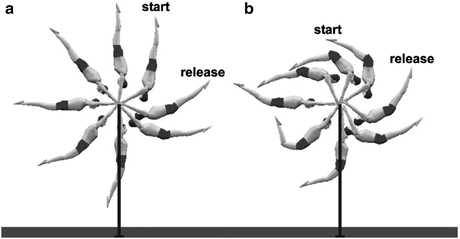Fig. 23.1
Graphics sequences of (a) recorded performance, and optimum simulations, (b) minimising joint torques and (c) producing vertical mass centre path (Hiley and Yeadon 2012)
In technical sports such as gymnastics the accuracy of timing and the accuracy with which the human motor system can perform movements will have a bearing on the movement strategies adopted. For example, prior to a dismount on high bar an accelerated giant circle is used to generate the necessary linear and angular momentum for the flight phase (Bruggemann et al. 1994). The traditional giant circle in which the body remains extended through the highest point has been superseded by a scooped giant circle in which the body flexes through the highest point and hyperextends at the lowest point of the circle (Fig. 23.2). An attempt to explain this change in terms of ability to produce more angular momentum failed (Hiley and Yeadon 2003a). The change was accounted for by considering the margin for error in timing the release (Hiley and Yeadon 2003b). The scooped technique exhibited larger release windows for successful dismounts, where the release window was defined as the period of time during the giant circle where the gymnast had sufficient linear and angular momentum to successfully perform the dismount. The larger the release window the more time during the giant circle the gymnast has the appropriate release conditions. As a result using the scooped technique the gymnast has the impression that timing the release is easier compared with the traditional technique. In reality, when using the scooped technique the timing becomes less critical as there is an extended period of time where a successful dismount can be performed.
In order to then maximise the angular momentum in the giant circles preceding a dismount, to either improve performance or investigate performing new dismounts, a constraint of a sufficiently large release window is required (Hiley and Yeadon 2005). As the amount of angular momentum at release increases the size of the release window decreases. For example, using a simulation model it was found that a gymnast is capable of producing sufficient angular momentum to perform a triple straight somersault dismount but the release window was found to be rather small (Hiley and Yeadon 2005). When the angular momentum was limited by having a suitably large release window, a triple piked somersault dismount or a double twisting triple somersault was possible (Fig. 23.3).
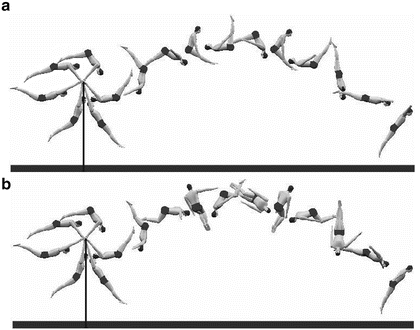

Fig. 23.3
Limiting dismounts using optimised giant circles with full strength: (a) triple piked somersault, (b) triple somersault with two twists (Hiley and Yeadon 2005)
23.3 Variability
In all sports activities there is inherent variation so that no two performances are exactly the same. As a consequence skilled technique needs to be successful in a noisy environment and so optimised technique needs to be robust to the inherent variation in coordination. It is necessary to determine the level of variability in order to conduct such optimisation studies. This was investigated for regular and accelerated giant circles on high bar (Fig. 23.4). Four elite male gymnasts each performed ten regular giant circles in succession, where the aim was to swing from handstand to handstand with good form and even pace (Fig. 23.4a) and ten double straight somersault dismounts, from which the preceding accelerated giant circles were analysed (Fig. 23.4b). For giant circles the actions performed through the lowest part of the circle have been shown to be mechanically the most important (Arampatzis and Bruggemann 1999; Irwin and Kerwin 2007; Yeadon and Hiley 2000) since they provide the necessary input of energy into the system for the gymnast to swing back above the bar for regular circles and they help generate the required linear and angular momentum (and hence release window) for the subsequent dismount for the accelerated giant circles.
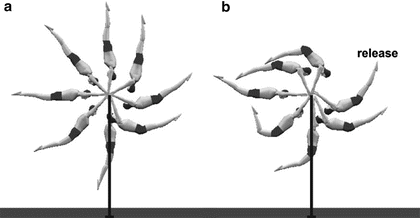

Fig. 23.4
Two types of backward giant circles performed on the high bar: (a) the regular giant circle and (b) accelerated giant circles
The trials for each gymnast and each type of giant circle were aligned when the mass centre was level with the bar (time zero in Fig. 23.5). The amount of movement variability was quantified in terms of the standard deviations of the time and angle at turning points between flexion and extension at the hip and shoulder (Fig. 23.5). The gymnasts’ movement patterns were very consistent through the lower part of the circle, with average standard deviations (from hip and shoulder) of 15 and 11 ms for the regular and accelerated circles, respectively. Through the upper part of the circles the average standard deviation was larger (93 ms) for the regular giant circles, whereas the average standard deviation for the accelerated giant circles was 12 ms. It was found that the more elite gymnasts were more consistent in the mechanically important aspects of technique.
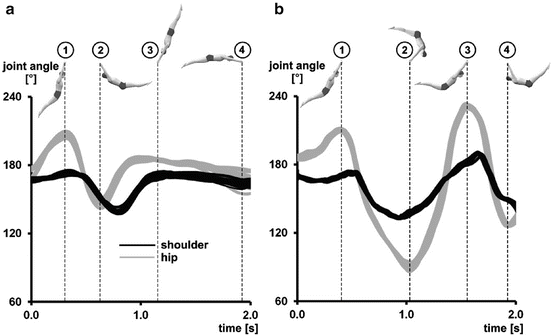

Fig. 23.5
Time histories of the hip and shoulder angles for ten (a) regular and (b) accelerated giant circles, with graphics to show the gymnast orientation (Hiley et al. 2013)
It is speculated that the gymnasts try to perform the mechanically important aspects of technique as accurately as possible, i.e. try to minimise the amount of variability in these actions, since they have a direct effect on the successful outcome of the skill. In order to achieve this, the gymnast uses feedback control through the upper part of the circle where adjustments can be made (e.g. to the whole body angular velocity) to ensure that the mechanically important aspects can be timed correctly. Although the gymnasts appear to be more variable through the upper part of the circle, they are performing the necessary corrections to prepare for the mechanically important actions.
The level of variability in gymnasts’ movements has implications for the results of optimisation studies and the techniques adopted. Optimal technique, by definition, is sensitive to perturbations, therefore introducing small timing errors can lead to sub-optimal performance. In the piked triple somersault dismount shown in Fig. 23.3a it was found that when the timing of the actions at the hip and shoulder joints of the optimum simulation were perturbed by 30 ms, the resulting simulation could no longer meet the criteria for a successful dismount (i.e. sufficient aerial rotation and release window, Fig. 23.6a). Since it is to be expected that a gymnast’s technique can cope with small errors in timing for consistent performance, a requirement of robustness to timing perturbations should be included within the optimisation process. When the technique in the backward giant circle was optimised to be robust to 30 ms perturbations it was found that sufficient linear and angular momentum for a triple piked dismount could be achieved with a realistic release window (Fig. 23.6b).
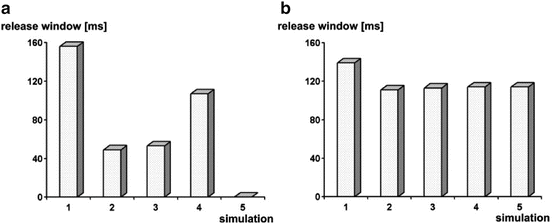

Fig. 23.6
The size of release window when the (a) maximised and (b) robust to 30 ms simulations are perturbed by 30 ms using five different perturbation combinations – [1] the unperturbed simulation, [2] shoulder and hip actions early, [3] shoulder and hip actions late, [4] shoulder early with hip late, and [5] shoulder late with hip early (Hiley and Yeadon 2008)
Gymnastics is a sport that demands consistency. For a gymnast to include a skill in a routine a success rate of over 90 % would be expected. Reasons for inconsistency include: poor technique, lack of strength, lack of flexibility and poor coordination precision which refers to how accurately the gymnast can produce the desired movements. We know that the motor system is noisy and that there will be variability in the movements when the gymnast tries to perform the same skill a repeated number of times.
Stay updated, free articles. Join our Telegram channel

Full access? Get Clinical Tree


